Biblically Accurate Angels: Christianity’s Undisputed Horror Icons
When I was a kid my church’s Sunday School would do an annual Christmas recital. On a number of occasions I played the coveted role of an angel, donning the generally accepted garb of a white robe, plastic wings, and tinsel halo. While my ‘angel’ was more of the dollar store variety, it ticked the boxes of how we’ve been conditioned to imagine the gentle appearance of God’s loyal agents: big feathery wings, shiny golden halo, and flowing white robes. If we go by the depiction of angels throughout art history (especially during and after the Renaissance), they’re depicted as beautiful creatures with soft features, graceful mannerisms, and wavy blonde hair.
And if we were to actually read The Bible, we’d find written descriptions to back these images up… right?
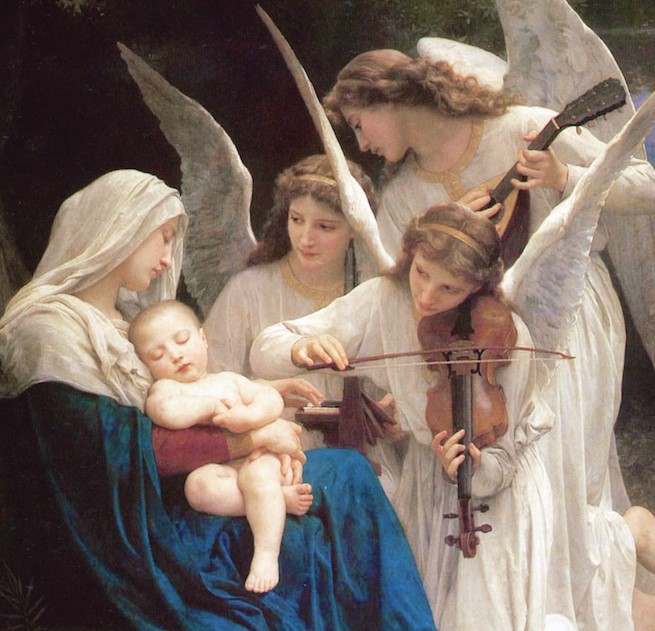
Detail from ‘Song of the Angels’ by William-Adolphe Bouguereau. Oil on canvas, 1881. In the collection of Forest Lawn Museum, California. (source)
In 2016, a viral Tumblr post by user revolution19 brought the internet’s attention to the fact that some angels aren’t the beautiful, soft, feminine creatures of our imaginations… they are Eldritch Abominations straight from our worst nightmares. And this isn’t a blind accusation, nor is it meant to make a mockery of Christianity. The evidence is readily available if you crack open a Bible and take a look at a few (completely bizarre) passages — which we’ll get to shortly.
Depending on your specific brand of Abrahamic religion, the names of angels and where they sit in the general angel hierarchy varies. In Judaism angels are broken down into ten ranks, though these ranking systems differ depending on the text. Alternatively, Islam doesn’t have any hierarchical system at all in place for angels, but they are more directly involved in the everyday life of humans when compared to Judaism and Christianity.
In Christianity the most influential angelic hierarchy was proposed by Greek author Pseudo-Dionysius the Areopagite in his De Coelesti Hierarchia (or, “On the Celestial Hierarchy”) sometime around fifth-century CE and contains nine orders and three hierarchies of angels. The higher the classification of angel sits within the hierarchy represents their overall closeness to God.
| First Tier | Seraphim | Cherubim | Thrones |
| Second Tier | Dominations | Virtues | Powers |
| Third Tier | Prinicipalities | Archangels | Angels |
[Note: For our purposes, we’ll be referencing the Pseudo-Dionysius hierarchy. I wanted to mention the discrepancies you’ll find between the ranking of angels not only between religions but also within Christianity. Alternative Christian angel rankings were proposed after Pseudo-Dionysius’ during the medieval period that I won’t be including here for the sake of simplicity.]
While the archangels Michael, Gabriel, and Raphael are the most well-known of the angels, they’re a little too ‘normal’… too mainstream. I want to talk about the First Tier, the heavy hitters — Seraphim, Cherubim, and Thrones. Because frankly they are terrifying and wonderful and no one talks about them enough. So let’s dive in!
Thrones or ‘Ophanim’
According to Pseudo-Dionysius, Thrones are found in the first tier and third rank of the overall angel hierarchy. Thrones are also called Ophanim and refer to beings that Ezekiel witnessed in his vision from Ezekiel 1 in the Old Testament. In his visions, Ezekiel saw the throne of God (or chariot) that featured Ophanim as the four wheels:
16 The appearance of the wheels and their work was like unto the colour of a beryl: and they four had one likeness: and their appearance and their work was as it were a wheel in the middle of a wheel.17 When they went, they went upon their four sides: and they turned not when they went.18 As for their rings, they were so high that they were dreadful; and their rings were full of eyes round about them four.
Ezekiel 1: 15-18 (KJV)
As the original Tumblr post observed, Ezekiel can’t seem to comprehend what he’s seeing since the existence of a creature in such close proximity to God is beyond the scope of human understanding. He observed the heavenly vision in awe, and the vision observed him back… with millions of unblinking eyes. Needless to say, artists have had a great time creating their interpretation of Ophanim based on Ezekiel, each more terrifying than the last:
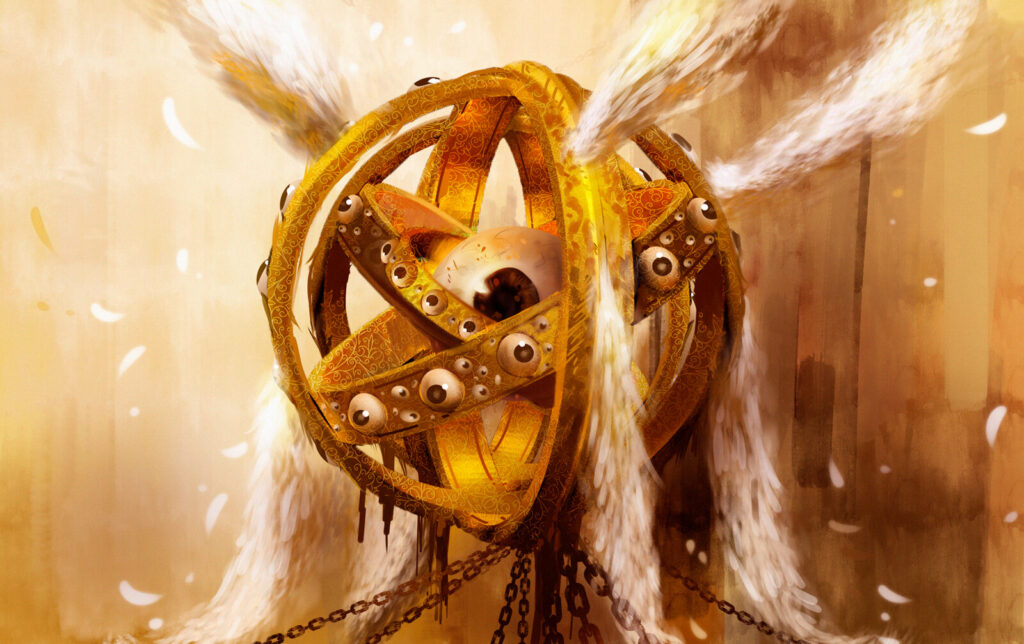
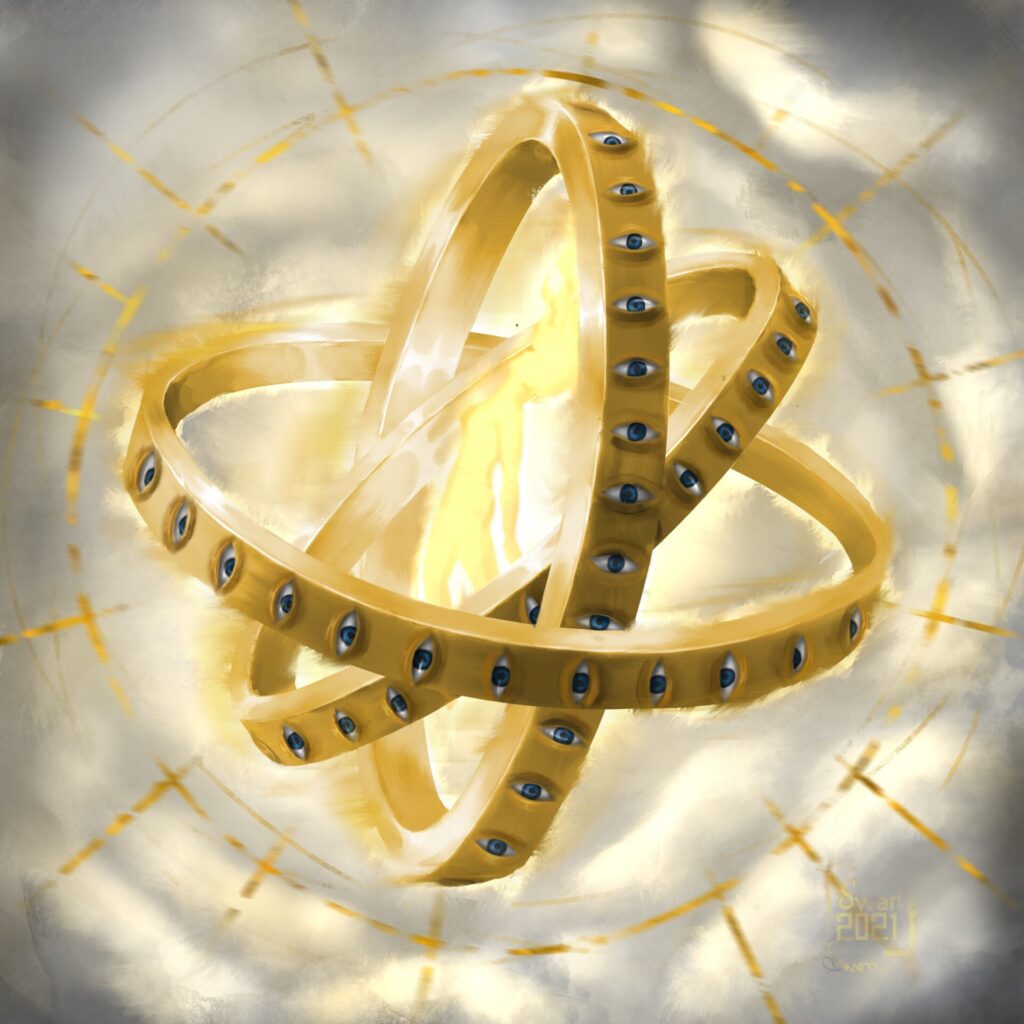
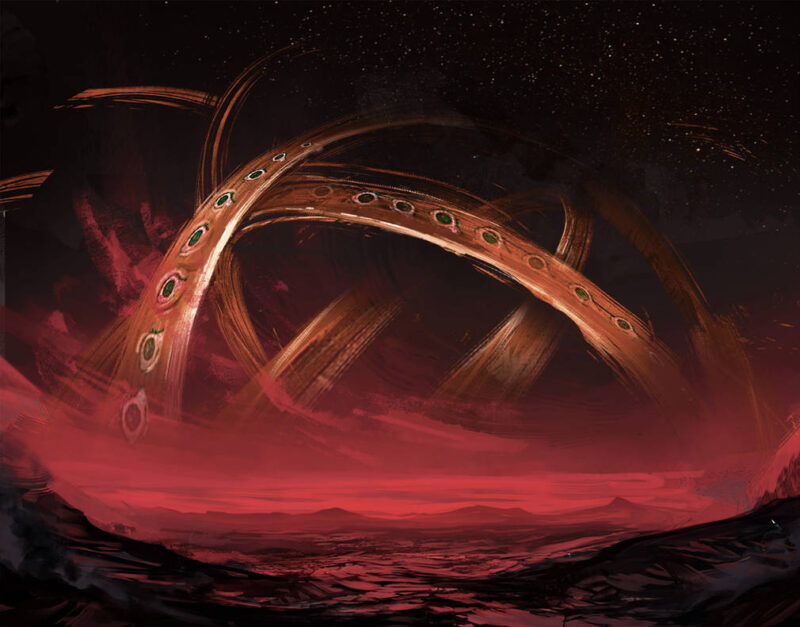
Interestingly, Ophanim are not directly classed as ‘angels’ within The Bible. The earliest text that makes this distinction is known as the Book of Enoch, which is an ancient Hebrew apocalyptic religious text written by the great-grandfather of Noah (of Noah’s Ark fame) sometime between 300 and 200 BCE. Here he writes:
And He will summon all the host of the heavens, and all the holy ones above, and the host of God, the Cherubic, Seraphin and Ophannin, and all the angels of power, and all the angels of principalities, and the Elect One, and the other powers on the earth (and) over the water.
Book of Enoch 61:10 (source)
The Book of Enoch also contains information on demons, giants, and fallen angels, so a fun read if you ever find yourself bored on a Tuesday night. While some consider it Biblically canon, specifically the Ethiopian Orthodox Church and the Ethiopic Bible, The Book of Enoch is most often sourced as an extrabiblical text. Other examples of extrabiblical concepts include the three wise men (an exact number isn’t recorded in The Bible), the seven-deadly sins (designated by Pope Gregory the Great c. 6th CE), and the Apocrypha which are ancient books that sometimes are and sometimes aren’t considered Biblically canon for a number of complicated reasons. Jesus’ birthday being on 25 December is also a extrabiblical concept since it isn’t actually stated anywhere in the Gospels. So just because something isn’t in The Bible doesn’t mean it isn’t considered ‘Truth’, at least in terms of tradition.
Further illusions of Ophanim as angels can be found in the Dead Sea Scrolls from the 3rd c. BCE – 1st c. CE, which references the Book of Ezekiel and Ezekiel’s visions of God’s chariot. Whether or not you consider Ophanim angels, the fact that they exist in The Bible at all is interesting — and terrifying — in itself.
Cherubim
You’ve almost certainly heard of these types of angels before, but you probably know them by their shortened named “Cherub”. When we think of Cherubs, we likely imagine chubby little babies with curly hair and little wings. So cute, right?
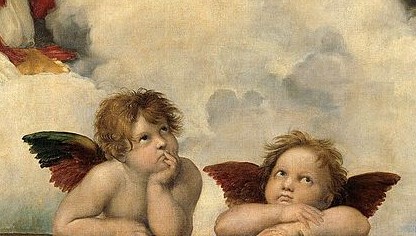
The painting above shows the generally accepted iconography of a Cherub. These two cuties are found along the bottom of Raphael’s Sistine Madonna and appear on pretty much every piece of Renaissance-related gift shop memorabilia. However, these figures are actually called putti and are found in both religious and secular artwork. Their iconography can represent romantic/erotic love (via Venus and her son Cupid), infer an association with Heaven and the omnipresence of God, or to simply imply leisure, peace, and prosperity.
Using imagery of Putti definitely softens the blow of what an actual Cherub looks like. The reality is less adorable and more akin to something your brain would conjure up during a really, really bad trip.
We return once again to Ezekiel, because the poor man’s vision not only contained Ophanim but Cherubim as well:
5 Also out of the midst thereof came the likeness of four living creatures. And this was their appearance; they had the likeness of a man. 6 And every one had four faces, and every one had four wings. 7 And their feet were straight feet; and the sole of their feet was like the sole of a calf’s foot: and they sparkled like the colour of burnished brass. 8 And they had the hands of a man under their wings on their four sides; and they four had their faces and their wings. 9 Their wings were joined one to another; they turned not when they went; they went every one straight forward.
10 As for the likeness of their faces, they four had the face of a man, and the face of a lion, on the right side: and they four had the face of an ox on the left side; they four also had the face of an eagle. 11 Thus were their faces: and their wings were stretched upward; two wings of every one were joined one to another, and two covered their bodies. 12 And they went every one straight forward: whither the spirit was to go, they went; and they turned not when they went. 13 As for the likeness of the living creatures, their appearance was like burning coals of fire, and like the appearance of lamps: it went up and down among the living creatures; and the fire was bright, and out of the fire went forth lightning. 14 And the living creatures ran and returned as the appearance of a flash of lightning.
Ezekiel 1: 5-14 (KJV)
The ‘living creatures’ Ezekiel is describing in above passage are confirmed as Cherubim a few chapters later:
20 This is the living creature that I saw under the God of Israel by the river of Chebar; and I knew that they were the cherubims. 21 Every one had four faces apiece, and every one four wings; and the likeness of the hands of a man was under their wings.
Ezekiel 10: 20-21 (KJV)
Along with the terrifying wheels of the chariot (Ophanim), we have the chariot’s throne bearers, which look absolutely nothing like a cute little baby. According to Ezekiel we’re dealing with a creature with four faces consisting of an ox, an eagle, a man, and a lion, along with two wings (presumably for each head… so eight wings) and hoofed feet. Cherubs don’t move around by flapping their teeny little wings — they glide around like creepy UFOs. When navigating they never have to rotate or turn since their four heads are already pointing conveniently in every direction. Much like the Ophanim, it’s beyond comprehension of our mere mortal understanding and dives face first into the realm of bizarre.
For my fellow former Catholic high school students, the four faces of a Cherub probably sound familiar. That’s because the Four Evangelists – Matthew, Mark, Luke, and John – are often represented by a man, lion, ox, and eagle respectively. This concept, known as a tetramorph, actually derives from Ezekiel’s vision.
So despite what Valentine’s Day cards and Renaissance artist’s told us, this is what an actual Cherub looks like:


Here are a couple examples depicting Ezekiel’s vision with both Cherubim and Ophanim:

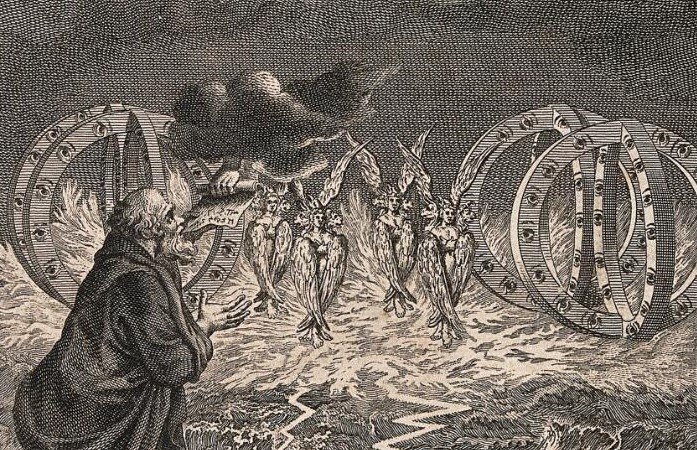
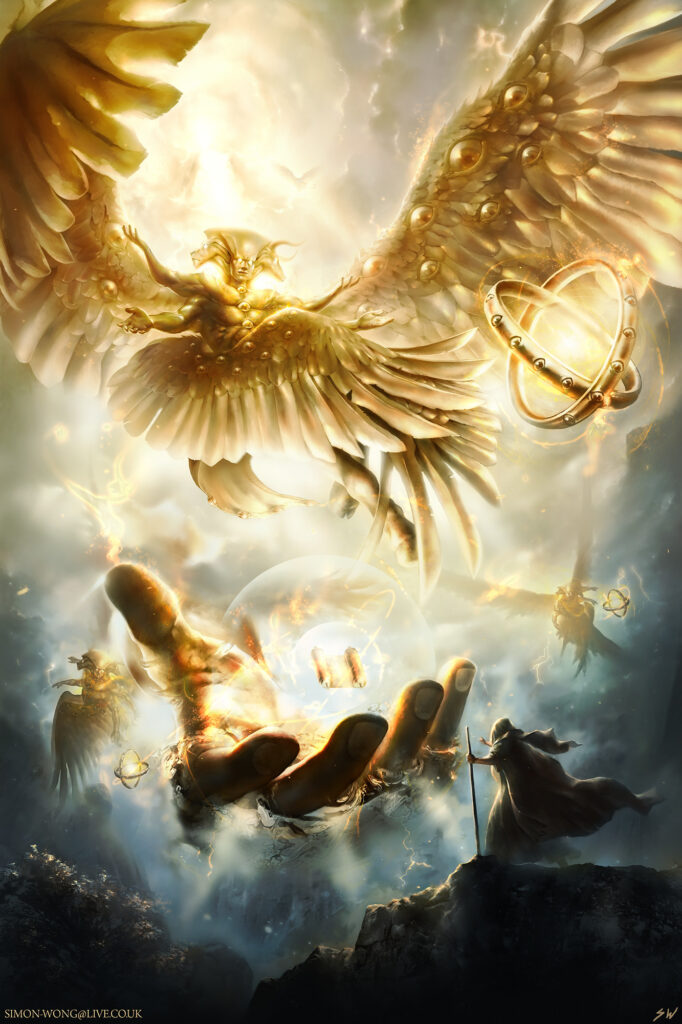
Poor Ezekiel had a lot to process. Outside of his vision, there are no other written descriptions within Biblical canon of the visual characteristics of Cherubs, despite being mentioned 91 times in the Hebrew Bible. So let’s hope Ezekiel got it right! The exact role of the Cherub is also never explicitly stated, but Hebrew tradition alludes to their guardianship of the Garden of Eden. They were also said to be present on the mercy seat of the Ark of the Covenant (aka the ark’s ‘lid’, but that doesn’t sound as fancy).
Seraphim
For our final angel, we’re moving away from the visions of Ezekiel and turning instead to Isaiah. The Book of Isaiah, also located in the Old Testament, was written sometime during the 8th-century BCE (partially) by the prophet Isaiah. Like Ezekiel, Isaiah saw a vision of God on his Heavenly throne. But instead of Cherubim and Ophanim, Ezekiel witnessed the highest ranking angel — the Seraphim.
6 In the year that King Uzziah died, I saw the Lord sitting on a throne, high and lifted up, and the train of His robe filled the temple. 2 Above it stood seraphim; each one had six wings: with two he covered his face, with two he covered his feet, and with two he flew. 3 And one cried to another and said:
“Holy, holy, holy is the Lord of hosts;
The whole earth is full of His glory!”4 And the posts of the door were shaken by the voice of him who cried out, and the house was filled with smoke.
5 So I said:
“Woe is me, for I am undone!
Because I am a man of unclean lips,
And I dwell in the midst of a people of unclean lips;
For my eyes have seen the King,
The Lord of hosts.”6 Then one of the seraphim flew to me, having in his hand a live coal which he had taken with the tongs from the altar. 7 And he touched my mouth with it, and said:
“Behold, this has touched your lips;
Isaiah 6: 1-7 (KJV)
Your iniquity is taken away,
And your sin purged.”
Isaiah’s vision shows a glimpse and brief interaction with God’s elite and Heaven’s ultimate nobility. While the Cherubs surround the throne of God, the place of the Seraphim is above, their status unmatched by any other rank of angel. And just like our Cherubs and Ophanim, Seraphim are described by Isaiah as nothing short of unsettling. Only two wings of the six-winged angels are actually used for flight while the other four are for covering their face and covering their feet. One interpretation of this suggests the Seraphim cover their feet because they are unclean and should not be shown before God, or alternatively to show the Seraphim’s unworthiness. And their faces are covered because their proximity to God’s full glory is so blinding, even for them.
The main role of the Seraphim is the eternal worship of God, as shown through the chanting of “Holy, holy, holy is the Lord of hosts; The whole earth is full of His glory!”. The coal taken from the altar of God and touched to the lips of Isaiah by the Seraphim represents the cleansing of his sins and his transformation into a prophet. The word ‘Seraph’ derives from the Hebrew verb sarap, which means ‘to burn’, so some say Seraphim could have an appearance akin to literal burning flames.
Here are a couple historic interpretations of Seraphim:
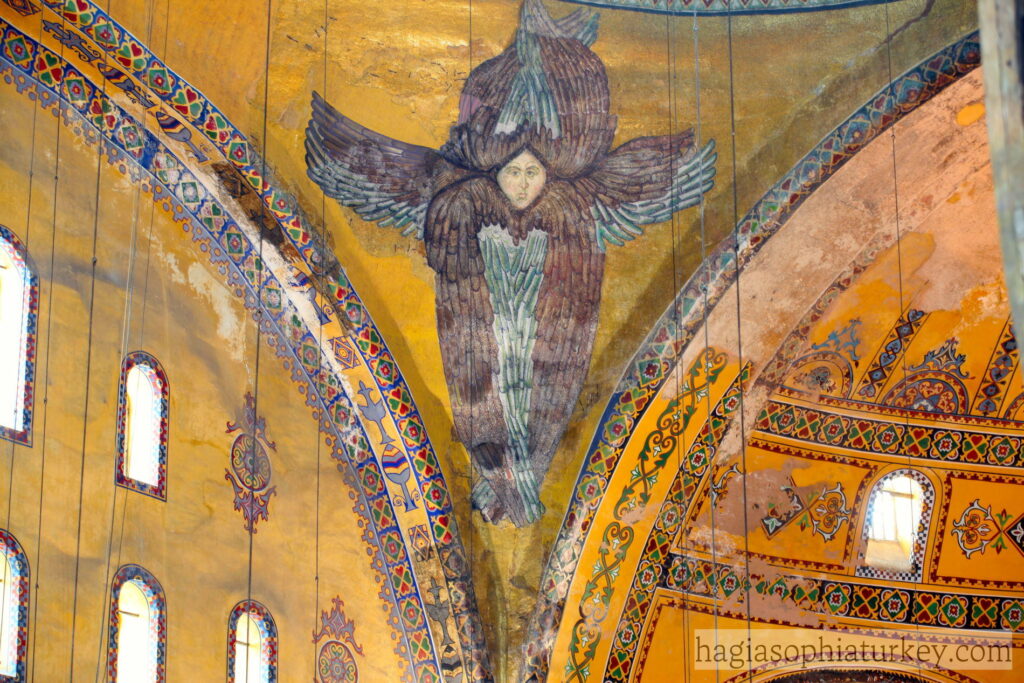
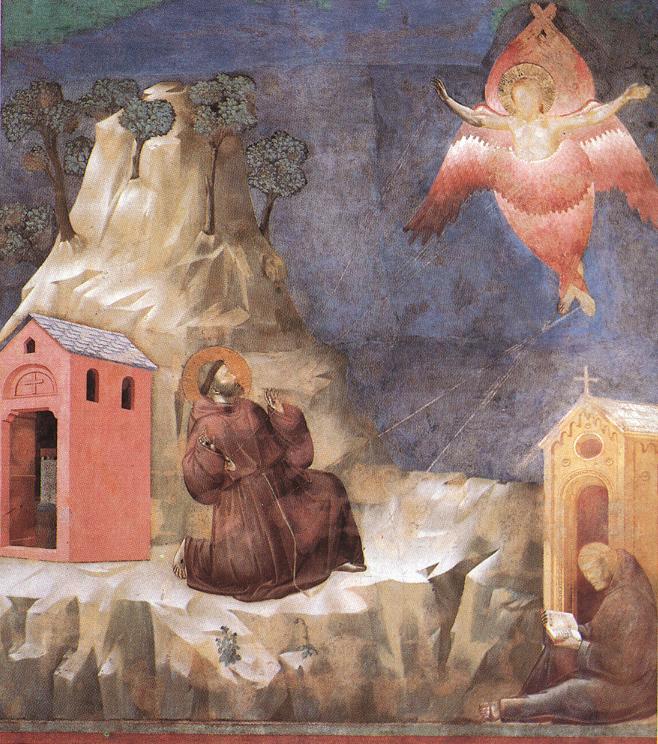
Six winged creatures that may or may not be on fire are certainly strange, but not nearly as strange as eye covered wheels and hovering four-faced hybrids. But Isaiah fails to include a creepy detail that actually liken Seraphim to Ophanim in one very unsettling way. As written in the apocalyptic Book of Revelation:
8 And the four beasts had each of them six wings about him; and they were full of eyes within: and they rest not day and night, saying, Holy, holy, holy, Lord God Almighty, which was, and is, and is to come.
Revelation 4:8 (KJV)
Revelation is a wild ride, so it’s not surprising Seraphim are described as being even more terrifying during their appearance at the end of the world. But Revelation was written around 800 years after Ezekiel by a completely different author (traditionally thought to be John the Apostle), so we allow for some obvious discrepancies. Below is an example of the Seraphim as detailed in Revelation:

Thankfully, it appears that none of these higher ranking angels actually leave Heaven or God’s side, so there’s no risk of them giving you a heart-attack inducing jump scare at 3am. So think again next time you roll your eyes at Christian mythology — The Bible has some storylines and creatures that would fit right in with the Cthulhu mythos.
For further horror, check out my favourite interpretation of Biblically Accurate Angels by artist Jonas Pfeiffer below (best experienced with sound on):
Sources and Additional Reading
Bible Study Tools – Ezekiel’s Wheel (2022) / Who or What Are the Ophanim, “the Wheels,” in the Bible? (2021) / What are Seraphim and What Power Do They Have? (2021)
The Leon Levy Dead Sea Scrolls Digital Library
Know Your Meme – Biblically Accurate Angels / Be Not Afraid (2020)
My Modern Met – Exploring the Heavenly History of Angels in Art (2021)
Mythology Explained – Ophanim In The Bible – The Angel Wheels of God (2021)
The New Yorker – I’m a Cherub and I Look Nothing Like a Fat Little Baby (2023)
Tumblr – revelation19: What do angels actually look like per the bible? (2016)
Vermes, Geza. The Complete Dead Sea Scrolls in English (Revised Edition) (2004)
Why Angels – Seraphim, Cherubim & the Four Living Angels
Wikipedia – Angels in Christianity / Book of Enoch / Putto / Seraph
